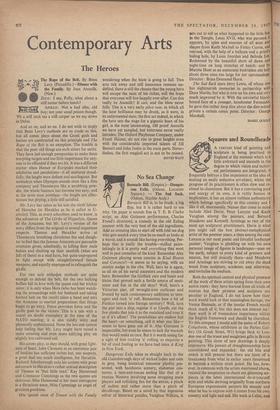Squares and Roundheads
A CERTAIN kind of painting and sculpture is being practised in England at the moment which is a little awkward and uncouth in the degree to which vision and techni- cal performance are integrated; it frequently betrays a fine impatience at the idea of making an easily seductive art-object, whilst the progress of its practitioners is often slow and in- clined to clumsiness. But it has a convincing pace and energy of its own, it is richly human in implication, it has an almost ruthless authenticity which belongs specifically to this country and I like it all, enormously. Names that come to mind include Alan Davie, Peter Lanyon and Keith Vaughan among the painters, and Bernard Meadows and Kenneth Armitage as two of the most apt sculptural practitioners. Davie is what you might call the best abstract-metaphysical artist of the postwar years, a titan among the rest; Lanyon is our most poetic and forceful landscape painter; Vaughan is plodding on with his own personal image of figures in landscapes—man on the earth, subject to every kind of pressure and tension, but still stoically there—and Meadows and Armitage are striving to cut away the dead wood from sculpture, academic and otherwise, and revitalise the medium.
Both the Spiritual content and physical presence of the work of these artists spring from their own native roots : they have learned from all kinds of sources but their pictures and sculpture are peculiar to England. I do not know how their work would look at that meaningless farrago, the Venice Biennale, or if the insular French would think much of it; but this does not interest me : their work is of tremendous importance within the English framework and should be cherished. To this company I would add the name of Robert Colquhoun, whose exhibition at the Parton Gal- lery (34 Greek Street, WI) brings back to Lon- don one of the truest and weightiest gifts in British painting. This show of new drawings is deeply impressive. His powers of draughtsmanship have consolidated and expanded : the old bite and attack is still present but there are hints of a breakaway from what in earlier years threatened to become a stylistic strait jacket. He has, how- ever, in common with the artists mentioned above, resisted the temptation to churn out glistening set- pieces in the latest international do-it-yourself ' style and whilst deriving originally from northern European expressionist painters his manner and what he has to express with it comes from his own country and light and soil. His work is Celtic, and in Celtic art—painting, literature or music—you always get an odd friction between the North and the South. Its main strength, in some ways : that old Celtic twilight is dazzlingly illuminated from time to time by thunderfiashes of southern exuberance and warmth. Colquhoun's acrid, grinding viewpoint is still narrow, he is still hold- ing too much in reserve, but he has gained in authority and his future explorations will be of immense interest.
I wonder how many of the artists participating in Lawrence Alloway's ably selected exhibition of British abstract art, Dimensions, at the O'Hana Gallery, can possibly develop along personal, compulsive and genuine paths? This is an engros- sing show containing much good work; but too much of it belongs on one side to that theoretical, constructivist, wildly out-of-date school of naive English commentators who seem to have just dis- covered Malevich, Domela, Mondrian and others; and on the- other to that equally naive group of disorientated painters for whom Pollock acted as a detonator.
I remember Pollock describing to me his early physical environment, his time in Mexico and the kindling of his imagination by Navaho Indian sand painting, a ritualistic, ephemeral art made of coloured sands poured on the ground from the hands of the artist. He spoke movingly and con- vincingly. Later, I saw the Navaho Indian work for myself. I can see its significance for Pollock but 1 cannot see its point when played around with by an enthusiastic simpleton in Earls Court. Too many of the works in Dimensions remind me of some happy square clapping his hands in time to the music but way, way off the beat.
BRYAN ROBERTSON



































 Previous page
Previous page